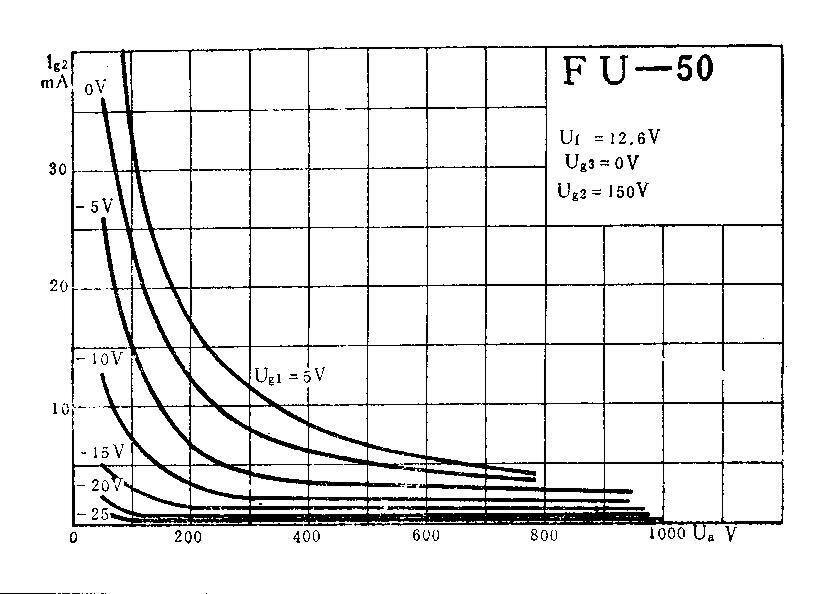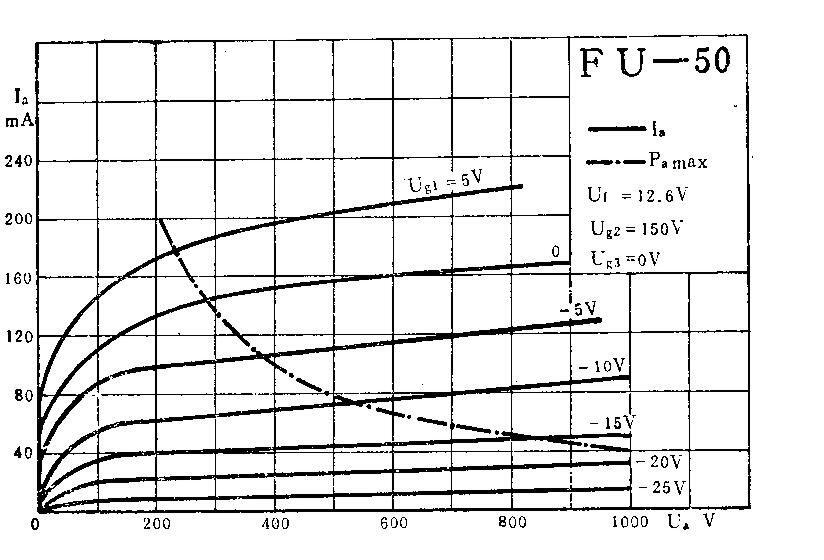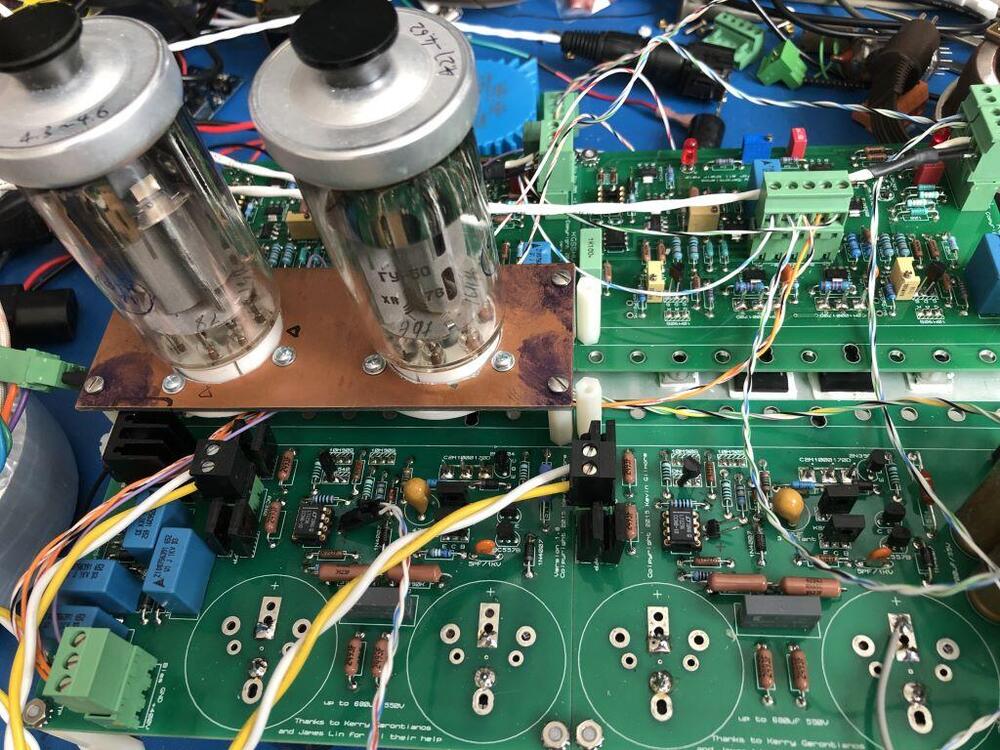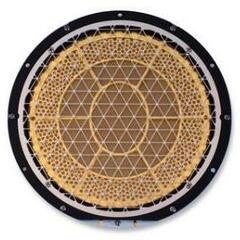Leaderboard
Popular Content
Showing content with the highest reputation on 05/06/2022 in Posts
-
Since you are getting so close to the Paltauf and understand how the circuit works, why don’t you share with us the details? There is no problem for an unaffiliated user to disclose what he/she can see in plain sight, I assume. What I can see is that sharing is part of the core spirit of this site and what drew us together to begin with.5 points
-
3 points
-
stax headphones are naturally balanced. There are two grids that high voltage audio is sent to. Between the grids there is a very thin statically charged sheet. To make the sheet move correctly one grid most have the opposite audio to the other so that one grid attracts the sheet while the other repels. If only one grid had audio (single ended output) the electric field created by the grid would drop off with square of the distance from the grid. So when the sheet is repelled it would move further away from the grid and be less effected by the voltage on the grid resulting in a loss of linearity. With two grids opposing each other the effect of moving away from one grid is directly counter-balanced by the effect of sheet moving closer to the other grid as well as creating a much more uniform electric field between the two grids. Thus maintaining linearity and improves efficiency - the same effect happens in electrostatic loudspeakers. So to drive the stax properly you need a balanced output. there are of course other advantages to balanced such a greater immunity to noise, longer permissible cable lengths, common mode noise cancellation etc etc. for the input to the Stax amp you can use single ended or balanced, however the single ended has to be converted to balanced at some point... disadvantage to balanced you need twice the amp components (excluding power supply which is usually shared between + and - halves of a channel)- if the amp balanced all the way through and probably a phase splitter to provide support for single ended inputs to the amp.2 points
-
the paltauf is not exactly poorly made. certainly not in the same junk class as eddie current and singlepower. both of which are now out of business. But the chassis is a standard hifi2000 with wood panels bolted to it. the wires attached to the metal panels for circuit board support are not really what i would consider acceptable. an unbalanced amplifier where one more tube would have made it balanced input would seem much more practical. and since we are comparing companies to companies, the woo audio es8 is basically the same thing at 1/3 the price. And built better.2 points
-
The saga of messing with my 2nd Carbon build continues. Since the circuit is very close to the Grounded Grid, I'd like to give it a try. Being hesitant to spend big bucks on a nice quad EL34, I have been on the lookouts for a cheaper substitute. The curve of a pentode looks a lot like that of a SiC FET. I need a pentode with the following properties: The plate curve should have low kinks or no kinks at the low Va range. The lower the 'knee' the better. Low Ig2. Ig2 should be much smaller than Ia (20mA), ideally 1mA or less under the operational Va range such that Ig2 doesn't interfere with cathode drive/ cathode degeneration. The amount of negative bias needed to get 20mA at 400V should be reasonably easy to handle. High rated Va(max) and Pa(max) for using a higher supply voltage and/or idle current in the future. That means I may need to look into transmitting tubes. And the candidate is... (drum roll please) the FU-50/GU-50! The linearity looks pretty good at around Ia=20mA, from Va=100V all the way to 1kV! The bias voltage is between -20V and -25V, right around what Carbon has. The Ig2 is really low and changes very little from Va=100V to 1kV. More importantly, the FU-50/GU-50 are relatively inexpensive and plentiful. A lot of them were made in the USSR and China during the cold war era. I read somewhere that those were designed for the comm gear used in the tanks and had very little success in commercial applications. I paid less than $3 a pop from Ukraine about 15 year ago. The going price for a NOS tube should be close to a SiC FET today. Well, any tube not designed for audio can be cheap these days. However, that wouldn't stop people from chasing after the Telefunken LS50 and the east-Germany SRS-552s, I guess 😉 Adapting those to the Carbon is surprisingly easy. I removed the SiC FETs and the 20k bias resistor, replaced the two 175k resistors with a 100V and a 130V 3W zener diode for G2 supply. The Ig2 is really small and the two tubes can share one set of the zener diodes. They drop 230V from GND and set Vg2 right at 150V, with about 22V left for the PZTA42 and the offset pot. The heaters are powered by a 12.6V filament trans with one side tied to B-. I could have tied the CT but there was very little hum to worry about. Guess what, the GU-50s work right out of the box. I didn't even need to adjust the balance and offset! The measured performance is pretty decent: Although the distortion is low, the FFT does show some higher order 'pentode nastiness'. I guess the reasons being The pentode is not super linear to begin with. The transconductance of the GU50 is about 1/10th of the SiC FET. The PZT42 has to work much harder and the global NFB is less effective. Something else worth looking into I'm not yet able to seriously listen to the sound, because I couldn't find another pair of tube sockets in my stash for the second channel 😂. If you want to know how it sounds, try it! The GU50 with 400V PSU comfortably beats the KGST (below) on the frequency response and the output swing: Next to try is to use the pentodes on the KGST, or should I call it KGSP then?1 point
-
Yeah, those should work as long as they are the same footprint as the others.1 point
-
1 point
-
If you would get a little bit closer to the Paltauf, you maybe would recognize that a second tube would not help to balance the amp. Why? Because he doesn't use tubes as phase splitter. If you are interested how this circuit works, you better have a closer look or ask Paltauf personally. I think there was enough fake spreaded from people who have never been close to what they are writting about.1 point
-
Watched the first episode of the new Star Trek series last night: Strange New Worlds. Overall I liked it a lot and feel that it has the potential to be right up there with TNG. The coolness & quality outweighed the occasional eye rolls, IMO. It had that Roddenberry feel that has been missing for a long time and I really like almost all of the cast members, especially the Big 3. I also liked all of the Easter Eggish tie-ins with the original series, pretty cool for an old Trekkie like me.1 point
-
all electrostatic headphones are balanced loads. much better and lower distortion to have a balanced input. otherwise you need a phase splitter which is not guaranteed to maintain a gain of -1 as the mu of the tube changes with time. much better to use a differential input amplifier. and once you do that you already have the balanced input. its certainly cheaper to do an unbalanced input amp. if for no other reason a 2 gang vs 4 gang pot. unless you are eddie current and use a 2 gang pot for balanced input. (similar to bryston)1 point
-
Trading up from a standard KGSSHV to a Carbon is logical. None of them are from those reputable builders, or in the EU. So no, I haven't seen anybody switching to this shitbox just yet, but one never knows based on how some people think. I can only say I am really surprised (saddened) that some people just willingly refuse to use any of their senses, when everything is laid out quite clearly for them to see - if they want to, but that's their choice. Unfortunately, at this place, BS comes out as what it is, which is BS.1 point
-
aeras is a fully dc coupled design similar to blue hawaii with no caps in the signal path and no output iron. for those people that want a smaller single box design. beautifully built with custom chassis and quality parts. does anyone really want an inductor based design? take a megatron, remove 4 of the output tubes and add lundahl center tapped inductors and output capacitors. or if you want something physically smaller, pick your favorite 5 watt pentode and do the same thing point to point. i can certainly whip up a circuit board, people just have to decide which is their favorite tubes. maybe $800 in parts total of which $200 is the inductors.1 point
-
That's the answer from Paltauf to Spritzers Nd Gillmore critics: This is for readers interested in a little broader view: -3db at 5Hz and -1,5db at 100KHz, 0,04%thd at 100Vrms are the datas of our KHV-ES, without negative feedback! The KHV-ESD has about 8db feedback and the technical datas are even more impressive! A tube amplifier that is constructed propperly does not need any feedback to work with very low distortion, wide bandwith and low noise - in contrast to amps with semiconductors. They depend on a very high amount of negative feedback with all the problems that come with it. Nelson Pass has written some very interesting articles about it. Transformers or anode chokes do not ask what they are made for, speakers or headphones! We choose the parts that meet our requirements or have them modified to make them fit into our amps. In our first hv amplifiers we used CCS (cascoded mosfet -tube) in the output stage but we could not see any advantage over a very high quality anode choke, on the contrary, we lost the k2 cancellation of the pp triode class a output stage with a transformer. Our amplifiers have an output voltage of a little more than 1000Vpp (up to 1100Vpp, with the 7189 tubes) so our transformer based amp will not destroys headphones! Step up transformers without amplitude limiting can do that very easily, I did some measurements recently, the voltage swing was a little less than 2,5 KV!! There are many ways to design a good amplifier, some do it with ss, others with tubes, we use the best of the two worlds and go our own way. And what is very important for me after 3 and a half decades in this business: I respect others, see the beauty and the drawbacks of other designs and what I really know is: there is no "best amplifier", it can only be my! favorite amp, nothing else! Readers who are interested in more detailed information can contact us directly, we will be happy to answer your questions! kind regards to all forum members - Wolfgang Paltauf1 point
-
1 point
-
Quixotic Martina Topley-Bird 2003 https://album.link/i/1458137669 Example: Diverse album with a lot of different styles. I liked it; I will check out her recent stuff1 point
-
It has all the same issues as the Woo Audio WES, their absurdly expensive unit, probably the new ES8 (based on the tube choice) and the LTA unit. The biggest issue is how the tubes are being driven, i.e. a center tapped inductor. With a normal loudspeaker, this isn't an issue but with electrostatic loads, it creates a lot odd issues and they can be clearly heard, if you know what you are looking for. It is not linear and neutral as it moves through the frequency range so to be simple, a high quality CCS, is pretty much utterly inert to what the amp is doing, a resistor far less so but here you add an inductor to the mix and a lot of weird stuff happens. Now why use inductors, well they are cheap all told. Palatauf are using nice Lundahl units but compared to the cost of CCS's and cooling it, it is a cheap option. Second reason, lot of voltage swing but that is problematic on its own. I've been hearing through the grapevine that Stax are not happy about these amps and why they've come so hard down on warranty repairs for headphones. A brief burst from one of these amps will kill the drivers at high volume levels1 point
-
I'm finally able to put a closure on this pentode experiment, sorta. What finally improved the THD figure between 300V and 500Vrms output is the driver transistor. I replaced the PZTA42s with TTC004Bs when trying the original GG circuit with EL34s, while the PZTA42s remained in the left channel. With SiC FET as the output device, the driver transistor has a pretty steep load line, so the nonlinearities on the upper left portion of the curve didn't matter that much, as long as the idle Vce is chosen to be high enough to avoid that area. With the GU50 tube as output device, the driver transistors not only need to swing current, but also swing voltage (about 10Vpp), so the load line is more flat. The nonlinearities of the transistor becomes more problematic. The PZTA42s have to go. The KSC2690s I have on the left channel have higher hFE than the TTC004B on the right. The two channels ended up having very close THD+N curves. The 2nd harmonic is more prominent than the 3rd in the left channel with the KSC2690s, not sure if that's consequential. The hum is 110dB below the 100Vrms mark, with the 12.6V filament transformer CT simply tied to B-. I'm quite happy with the sound on my SR-009. It has the basic characteristics of the Carbon with a very slight touch of tube softness, yet not losing resolution or immediacy. I searched up and down but didn't find another pentode more suitable for this role, at least on paper. If some day I manage to put this into an enclosure, the ugly 'hats' would surely be sticking out.1 point
-
Fleetwood Mac - Tusk (Deluxe Edition) The demo versions of the songs on this deluxe edition are fun, but I'm loving the live tracks from the Tusk Tour in '79 and '80 the most. These polished studio gems sound a little rougher and a little livelier in a concert setting. https://music.apple.com/us/album/tusk-deluxe-edition/10523984761 point
-
The Grand Illusion Styx 1977 https://album.link/i/1440713335 Example:1 point
-
So, this week Family Guy had a musical segment featuring a song 'loving you". I liked it and thought I had heard it before. It took a lot more searching that I would have thought to find an old show tune. But in the end, I found it - in the movie - She's Working Her Way Through College - 1952 (sounds more suggestive than it is) A Reagan flick. I'll Be Loving You Music by Vernon Duke Lyrics by Sammy Cahn Performed by Virginia Mayo (dubbed by Bonnie Lou Williams) and Gene Nelson It has a very impressive dance sequence - I could see there being many accidents and injuries. Family Guy Version. -- probably will get blocked at some point. Okay back to watching Bob's Burgers.1 point
-
Just watching someone struggle to count back change today boggles my mind.1 point
-
1 point
-
Picked up a gift certificate at a local spa for my wife for Mother's Day. I wanted to give the monetary equivalent of three 50-minute massages ($87 each). The person getting the GC for me asked her co-worker what 3 times the price was, and before she could even pull out the calculator, I told her the amount. They both stared at me in awe, the second one double-checked my "work" and proclaimed I was right. they spent the next few minutes completing the card, and talking about how good I was with math. Scary.... They certainly LOOKED lovely.... 😂1 point
-
Now we are talk'in 😉. The tube channel has become really close to the SiC FET channel, both at 100V output. The performance is not yet at the Carbon level, but is pretty good for a tube amp. What was the problem with the previous mod? The simplified G2 supply didn't work well. This tube is quite sensitive to Vg2 (which may make it a good candidate for G2-drive applications, given the low Ig2). The previous circuit has Vg1 as part of Vg2, so the Vg1 variations causes Vg2 changes. The solution is to use one 150V zener diode for each tube, put it across G2 and K, and feed <1mA of current from GND using a resistor or a current source. I also added a 10uF capacitor in parallel with the zener. Without it, the output clips at around 300V but the distortion still looks good before the clipping. Now the circuit should deserve an audition. Since the main problem is the knee on the Ia curve and Ig2 curve below Va=100V, with higher B- (500V maybe?) and perhaps higher current, the tube circuit should perform even better. I'll leave that to the next episode. For now I'm waiting for the sockets from China to build the other channel.1 point
-
Congratulations Kerry, I will follow the comments carefully. Being manufactured in Greece, shipments within the EU will be free of customs1 point






















